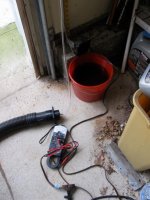If I split a 6" pipe into two 4" or four 3" openings and lets say I connect each of them to a small machine that uses such hose size... I am assuming I don't want to gate them further? Or, if I do that split, and only hook up one machine I want to leave the other openings open, don't close them off? This seems counter-intuitive to me.
You are using an out of date browser. It may not display this or other websites correctly.
You should upgrade or use an alternative browser.
You should upgrade or use an alternative browser.
Clarification on splits and gate usage
- Thread starter Absinthe
- Start date
Use a blast gate on each leg or cap them off if reserved for further use. You always want the best airflow from a machine that is in use. You also need to recognize that airflow will be substantially reduced versus 6" pipe. I'd keep the length of flexible duct to a minimum.
Absinthe,
The motor runs easier and takes less power when the pipe is necked down. In fact it takes the least power when you shut all blast gates. That is a characteristic of centrifugal fans. The problem with reducing the pipe size is that the airflow is reduced too much in the 6" pipe and if that happens you can get clogging.
bababrown
The motor runs easier and takes less power when the pipe is necked down. In fact it takes the least power when you shut all blast gates. That is a characteristic of centrifugal fans. The problem with reducing the pipe size is that the airflow is reduced too much in the 6" pipe and if that happens you can get clogging.
bababrown
Absinthe,
It seems to me that reducing a 6” pipe to four 3” pipes and then closing three of the four 3” lines with blast gates would, for sure seems intuitively more efficient, since air is only being sucked through the one 3” pipe and no suction is wasted. But a problem could arise back in the main 6” line, where air flow must be kept moving at a velocity greater than 3500 feet per minute. I suspect that a single 3” line through which air is pulled could reduce the velocity of air in the 6” line and allow debris to settle in the pipe. Leaving all four 3” lines open would, I suspect, ensure enough air is pulled through the main 6” line to keep debris from settling out.
Another aspect of reduced air flow in the cyclone, which I would think could occur if only one 3” pipe is used to collect dust would be related to separation of course and fine debris. As I understand cyclones, separation depends on the speed imparted to dust as it travels through the cyclone. The greater the velocity of the particle, the more likely it will be cast into the dust collection bin and remain out of the filter stack. If in fact that 3” single open pipe reduces the velocity of the particles, then more debris could end up in the filters.
My arguments could be affirmed or refuted with some measurements and calculations, but I am just not up to that task.
It seems to me that reducing a 6” pipe to four 3” pipes and then closing three of the four 3” lines with blast gates would, for sure seems intuitively more efficient, since air is only being sucked through the one 3” pipe and no suction is wasted. But a problem could arise back in the main 6” line, where air flow must be kept moving at a velocity greater than 3500 feet per minute. I suspect that a single 3” line through which air is pulled could reduce the velocity of air in the 6” line and allow debris to settle in the pipe. Leaving all four 3” lines open would, I suspect, ensure enough air is pulled through the main 6” line to keep debris from settling out.
Another aspect of reduced air flow in the cyclone, which I would think could occur if only one 3” pipe is used to collect dust would be related to separation of course and fine debris. As I understand cyclones, separation depends on the speed imparted to dust as it travels through the cyclone. The greater the velocity of the particle, the more likely it will be cast into the dust collection bin and remain out of the filter stack. If in fact that 3” single open pipe reduces the velocity of the particles, then more debris could end up in the filters.
My arguments could be affirmed or refuted with some measurements and calculations, but I am just not up to that task.
It seems now, from other conversations elsewhere that I will not be able to generate enough inches of static lift with this system to chip/dust collect from a small port. That suggests this is a fool's errand and I will need a secondary vacuum source, not unlike the ones they use in central vac units to collect from the smaller ports. This will inevitably require a secondary small cyclone also... I am not liking this answer, but based on the person it came from I am reluctant to dismiss it outright.
So I guess the solution I am looking for is: How do you collect dust/chips from ports smaller than 4" such as those on router tables, sanders, circular saws, hand-held routers and so on and so forth?
So I guess the solution I am looking for is: How do you collect dust/chips from ports smaller than 4" such as those on router tables, sanders, circular saws, hand-held routers and so on and so forth?
I changed the dust collection ports on my table saw and jointer up to 6" with shop made versions (3/4" plywood with hole cut with a flycutter on drill press[or use a jig saw with a starter hole inside the circle] and glue in a half of a PVC coupler as the port using Gorrilla Glue). Where I could not alter the ports to larger than 2", I use a Festool CT36 Dust Extractor that has a CV-06 mini-cyclone chip collector and then a hose to the device port (no gates involved). This works great for Miter Saw, spindle sander, stationary belt/disk sander. I use a 6 x 6 x 4 PVC wye for a separate 4" duct to my overhead Shark Guard on my Tablesaw. A ShopVac and mini-cyclone will cover most smaller port demands and effectively collect the coarse and fine dust smaller tools tend to produce. Works well for me.
I used a monotube manometer which is just a clear vinyl hose in a bucket of colored water with the hose stretched up a garage wall and looped back down to the vacuum. I have a tape fastened along the tube to measure column height. I used a rubber plug that fits tightly in the vacuum hose and which includes a barb fitting to hook up to the manometer. I think there are photos on my gallery section; Richard L brown along with other measurements.
bababrown
bababrown




